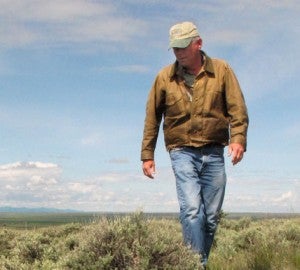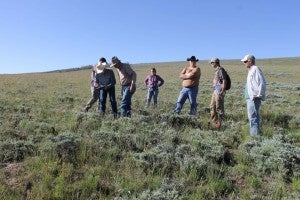
Nearly two dozen Nevada landowners have already submitted letters of interest to generate conservation credits for sage-grouse through the exchange. Read more >>
For the first time ever, ranchers are able to enroll in a habitat credit exchange program to earn revenue for activities that protect and enhance habitat for the greater sage-grouse.
The state of Nevada and federal agencies today announced the approved use of the Nevada Conservation Credit System to protect the grouse’s sagebrush habitat on public lands.
This program will create a robust mitigation market that will bring greater certainty and transparency to the state’s agriculture and energy industries, ultimately allowing both sage-grouse and the economy to flourish.
About the Nevada Conservation Credit System
The Nevada Conservation Credit System is an advanced approach to protecting habitat for the greater sage-grouse that ensures impacts are fully offset in a way that helps create net benefit. It does so by creating new incentives for industries to avoid and minimize impacts, and for private landowners and public land managers to preserve, enhance, and restore habitat.
Nevada has committed $2 million to fund the first round of pilot projects, which will be awarded to land managers, namely ranchers, on private and public lands. Dozens of ranchers have already expressed interest in generating conservation credits through these pilots, which can eventually be sold as mitigation to industry buyers.
“The habitat exchange is a win-win for sage-grouse and for ranchers, who are natural stewards of these vital working landscapes.”
The credit system will ultimately provide regulatory certainty for industries by fulfilling compensatory mitigation needs.
The first, but not the last
The Nevada Conservation Credit System is an evolution of similar conservation programs under development in other sage-grouse states, like the Colorado Habitat Exchange, which was formally submitted to the U.S. Fish and Wildlife Service by Governor Hickenlooper in September 2015 – just before the “not warranted” listing decision.
In addition to Nevada, Colorado has been a strong leader in developing innovative conservation solutions that work for both wildlife and the economy. Approval of the Nevada credit system is a good sign that the Colorado exchange will soon be open for business as well.
“The sooner we can get federal recognition of the Colorado Habitat Exchange, the sooner we will be able to unlock new opportunities for Colorado ranchers to make sage-grouse conservation a part of their business models,” said Terry Fankhauser, executive vice president of the Colorado Cattlemen’s Association. “The habitat exchange is a win-win for sage-grouse and for ranchers, who are natural stewards of these vital working landscapes.”
In order to keep the greater sage-grouse off the endangered species list in the long run, there needs to be strong conservation and mitigation markets in place that can drive momentum on the ground quickly, in keeping with the promises made by the states.
Approval of the Nevada credit system paves the way for other states to lead on sage-grouse, ensuring a sustainable future for wildlife and for the western economy.
Related:
Nevada landowners eager to generate conservation credits, help sage-grouse >>
$2 million available for Nevada landowners to earn revenue through sage-grouse pilots >>
Habitat exchanges: How do they work >>










